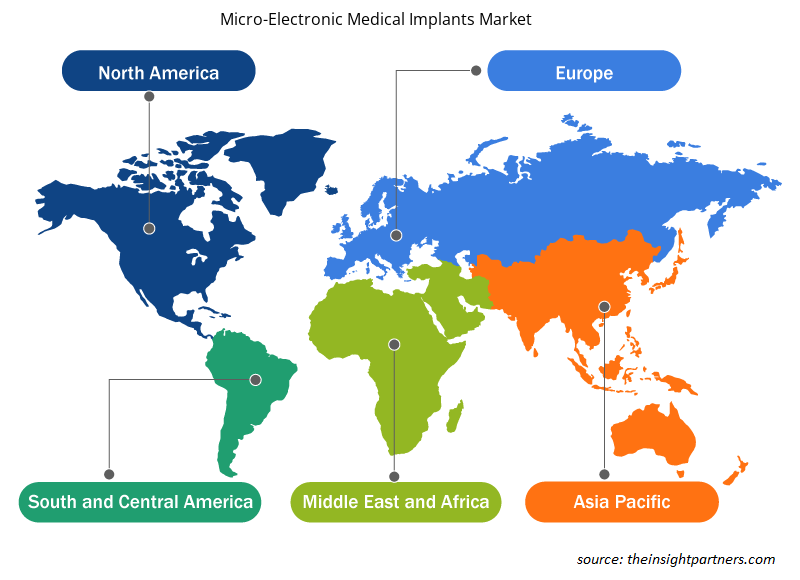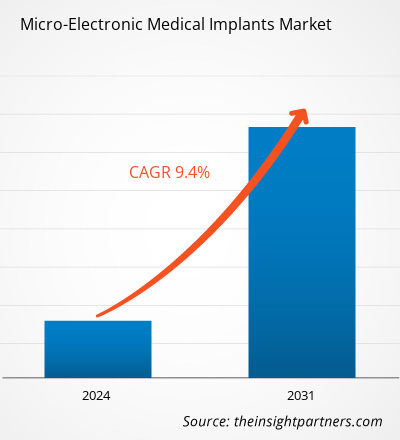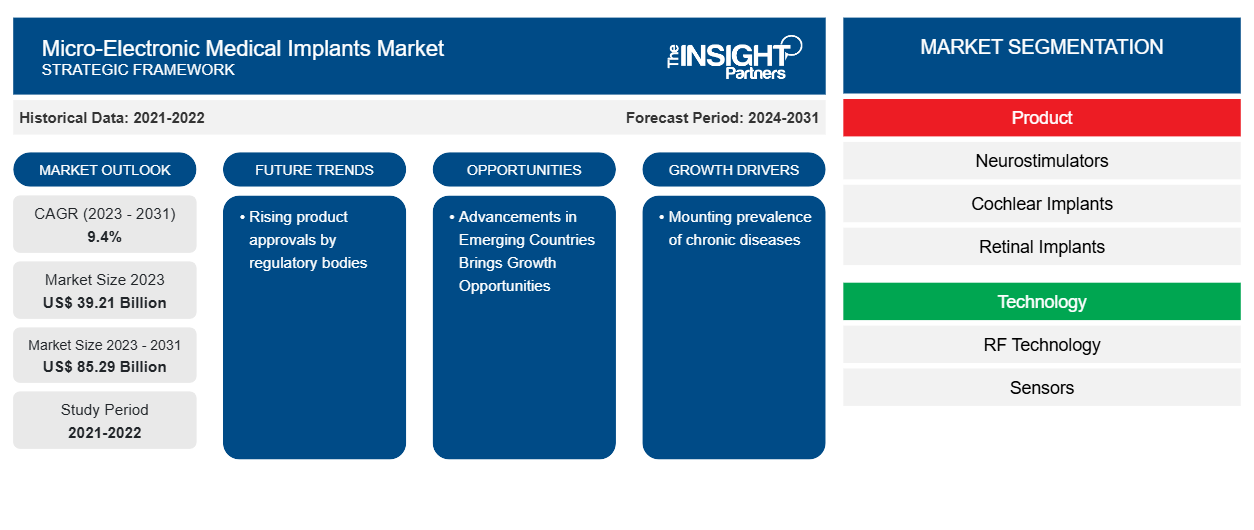Der Markt für mikroelektronische medizinische Implantate soll von 39,21 Milliarden US-Dollar im Jahr 2023 auf 85,29 Milliarden US-Dollar im Jahr 2031 anwachsen. Der Markt wird zwischen 2023 und 2031 voraussichtlich eine durchschnittliche jährliche Wachstumsrate von 9,4 % verzeichnen. Die Entwicklung neuartiger medizinischer Geräte und die Nachfrage nach personalisierter Medizin dürften weiterhin wichtige Trends auf dem Markt bleiben.
Marktanalyse für mikroelektronische medizinische Implantate
Implantierbare medizinische Geräte ermöglichen Überwachung, Diagnose und Therapie für eine Vielzahl von Krankheiten. Die Entwicklung dieser Geräte hat sich im Laufe der Zeit aufgrund bedeutender Fortschritte in der Elektrodentechnologie, Mikroelektronik und Verpackung deutlich weiterentwickelt. Medizinische implantierbare Geräte wie Herzschrittmacher, Cochlea-Implantate, Herzunterstützungssysteme, Rückenmarkstimulatoren und andere werden zur Behandlung verschiedener chronischer Erkrankungen eingesetzt. Die steigende Zahl chronischer Krankheiten erhöht die Nachfrage nach mikroelektronischen medizinischen Implantaten.
Marktübersicht für mikroelektronische medizinische Implantate
Laut einem von Yale Medicine veröffentlichten Artikel haben etwa 3 Millionen Amerikaner einen Herzschrittmacher, die Mehrheit davon sind ältere Menschen (etwa 70 % derjenigen, die einen Herzschrittmacher erhalten , sind mindestens 65 Jahre alt). Ein Herzschrittmacher ist ein Herzimplantat, das Sensoren zur Überwachung seines Rhythmus enthält und anhand dieser Daten bestimmt, wann und wie oft elektrische Impulse gesendet werden. Daher erhöht die hohe Nutzung von Defibrillatoren und Herzschrittmachern aufgrund von Herzinsuffizienz die Nachfrage nach mikroelektronischen medizinischen Implantaten.
Passen Sie diesen Bericht Ihren Anforderungen an
Sie erhalten kostenlose Anpassungen an jedem Bericht, einschließlich Teilen dieses Berichts oder einer Analyse auf Länderebene, eines Excel-Datenpakets sowie tolle Angebote und Rabatte für Start-ups und Universitäten.
- Holen Sie sich die wichtigsten Markttrends aus diesem Bericht.Dieses KOSTENLOSE Beispiel umfasst eine Datenanalyse von Markttrends bis hin zu Schätzungen und Prognosen.
Markttreiber und Chancen für mikroelektronische medizinische Implantate
Zunehmende Produktzulassungen durch die Regulierungsbehörden begünstigen den Markt
Die US-amerikanische Food and Drug Administration (FDA) bewertet medizinische Geräte mit hohem Risiko wie implantierbare elektronische Herzgeräte (CIEDs), Neurostimulatoren , Cochlea-Implantate und Netzhautimplantate im Rahmen des Premarket-Approval-Verfahrens (PMA), bei dem das Unternehmen seine klinischen Daten zur Gewährleistung von Sicherheit und Wirksamkeit einreicht. Premarket-Approval-Supplements werden verwendet, um Änderungen an bestehenden Geräten mit hohem Risiko zu genehmigen. So genehmigte die FDA im März 2022 den von der Valencia Technologies Corporation entwickelten peripheren Neurostimulator eCoin, der zur Stimulation der mit der Blasenkontrolle verbundenen Nerven bei Patienten mit Dranginkontinenz beitragen soll. Die zunehmende Zahl der Zulassungen durch diese Aufsichtsbehörden treibt das Wachstum des Marktes für mikroelektronische medizinische Implantate voran.
Fortschritte in Schwellenländern bieten Wachstumschancen
Die Verlagerung des Schwerpunkts auf medizinische Geräte mit innovativen Technologien in Entwicklungsländern erhöht die Nachfrage nach medizinischen Geräten mit integrierter Mikroelektronik. Entwicklungsländer wie Indien, China und die Vereinigten Arabischen Emirate erleben eine schnelle Entwicklung der Gesundheitsinfrastruktur und einen verbesserten Zugang zur medizinischen Versorgung aufgrund ihrer großen Patientenbasis und steigender Gesundheitsausgaben, was ein enormes Marktpotenzial für medizinische Geräte verdeutlicht. Darüber hinaus dürften die Präsenz wichtiger Marktteilnehmer und die von ihnen verfolgten Wachstumsstrategien Chancen auf dem Markt für mikroelektronische medizinische Implantate mit sich bringen.
Marktbericht über mikroelektronische medizinische Implantate – Segmentierungsanalyse
Wichtige Segmente, die zur Ableitung der Marktanalyse für mikroelektronische medizinische Implantate beigetragen haben, sind Produkt, Technologie, Anwendung und Endbenutzer.
- Der Markt für mikroelektronische medizinische Implantate ist nach Produkten segmentiert in Neurostimulatoren, Cochlea-Implantate, Netzhautimplantate, Herzschrittmacher und Defibrillatoren, implantierbare Medikamentenpumpen, Augenimplantate und andere. Das Segment Herzschrittmacher und Defibrillatoren hatte 2023 den größten Marktanteil.neurostimulators, cochlear implants, retinal implants, pacemakers & defibrillators, implantable drug pumps, ocular implants, and others. The pacemakers & defibrillators segment held the largest market share in 2023.
- Nach Material ist der Markt in HF-Technologie, Sensoren und Sonstiges segmentiert. Das Segment HF-Technologie hatte im Jahr 2023 den größten Marktanteil.
- Nach Anwendung ist der Markt in Kardiologie, Neurologie, Onkologie, Augenheilkunde und andere unterteilt. Das Segment Kardiologie hielt im Jahr 2023 einen bedeutenden Marktanteil.
Marktanteilsanalyse für mikroelektronische medizinische Implantate nach geografischer Lage
Der geografische Umfang des Marktberichts für mikroelektronische medizinische Implantate ist hauptsächlich in fünf Regionen unterteilt: Nordamerika, Asien-Pazifik, Europa, Naher Osten und Afrika sowie Süd- und Mittelamerika. Der Asien-Pazifik-Raum wird in den kommenden Jahren voraussichtlich mit der höchsten durchschnittlichen jährlichen Wachstumsrate wachsen.
Der Markt für mikroelektronische medizinische Implantate in Nordamerika wird anhand der drei wichtigsten Länder analysiert: USA, Kanada und Mexiko. Schätzungen zufolge werden die USA im Jahr 2023 einen größeren Anteil am nordamerikanischen Markt für mikroelektronische medizinische Implantate haben. Das Wachstum in dieser Region ist durch eine zunehmende Belastung durch chronische Erkrankungen wie Herz-Kreislauf-Erkrankungen, neurologische Erkrankungen und Hörstörungen, wachsende technologische Fortschritte und einen steigenden Anteil geriatrischer Bevölkerung gekennzeichnet.
Darüber hinaus wird erwartet, dass die Produktzulassungen durch die Regulierungsbehörden das Marktwachstum im Prognosezeitraum deutlich steigern werden.
Umfang des Marktberichts über mikroelektronische medizinische Implantate
Regionale Einblicke in den Markt für mikroelektronische medizinische Implantate
Die regionalen Trends und Faktoren, die den Markt für mikroelektronische medizinische Implantate während des Prognosezeitraums beeinflussen, wurden von den Analysten von Insight Partners ausführlich erläutert. In diesem Abschnitt werden auch die Marktsegmente und die Geografie für mikroelektronische medizinische Implantate in Nordamerika, Europa, im asiatisch-pazifischen Raum, im Nahen Osten und Afrika sowie in Süd- und Mittelamerika erörtert.

- Erhalten Sie regionalspezifische Daten zum Markt für mikroelektronische medizinische Implantate
Umfang des Marktberichts über mikroelektronische medizinische Implantate
| Berichtsattribut | Details |
|---|---|
| Marktgröße im Jahr 2023 | 39,21 Milliarden US-Dollar |
| Marktgröße bis 2031 | 85,29 Milliarden US-Dollar |
| Globale CAGR (2023 - 2031) | 9,4 % |
| Historische Daten | 2021-2022 |
| Prognosezeitraum | 2024–2031 |
| Abgedeckte Segmente | Nach Produkt
|
| Abgedeckte Regionen und Länder | Nordamerika
|
| Marktführer und wichtige Unternehmensprofile |
|
Marktteilnehmerdichte: Der Einfluss auf die Geschäftsdynamik
Der Markt für mikroelektronische medizinische Implantate wächst rasant, angetrieben durch die steigende Nachfrage der Endnutzer aufgrund von Faktoren wie sich entwickelnden Verbraucherpräferenzen, technologischen Fortschritten und einem größeren Bewusstsein für die Vorteile des Produkts. Mit der steigenden Nachfrage erweitern Unternehmen ihr Angebot, entwickeln Innovationen, um die Bedürfnisse der Verbraucher zu erfüllen, und nutzen neue Trends, was das Marktwachstum weiter ankurbelt.
Die Marktteilnehmerdichte bezieht sich auf die Verteilung der Firmen oder Unternehmen, die in einem bestimmten Markt oder einer bestimmten Branche tätig sind. Sie gibt an, wie viele Wettbewerber (Marktteilnehmer) in einem bestimmten Marktraum im Verhältnis zu seiner Größe oder seinem gesamten Marktwert präsent sind.
Die wichtigsten auf dem Markt für mikroelektronische medizinische Implantate tätigen Unternehmen sind:
- Sonova
- NeuroPace, Inc
- ABBOTT
- Medtronic
- Cochlear Ltd
- LivaNova PLC
Haftungsausschluss : Die oben aufgeführten Unternehmen sind nicht in einer bestimmten Reihenfolge aufgeführt.

- Erhalten Sie einen Überblick über die wichtigsten Akteure auf dem Markt für mikroelektronische medizinische Implantate
Marktnachrichten und aktuelle Entwicklungen für mikroelektronische medizinische Implantate
Der Markt für mikroelektronische medizinische Implantate wird durch die Erhebung qualitativer und quantitativer Daten aus Primär- und Sekundärforschung bewertet, die wichtige Unternehmenspublikationen, Verbandsdaten und Datenbanken umfasst. Nachfolgend sind einige der Entwicklungen auf dem Markt für mikroelektronische medizinische Implantate aufgeführt:
- MicroPort CRM hat die Markteinführung des implantierbaren Kardioverter-Defibrillators (ICD) ULYS und des Defibrillationskabels INVICTA in Japan angekündigt. Beide Geräte sind bei Implantation als System bei 1,5 Tesla und 3 Tesla bedingt MRT-tauglich. Der ULYS ICD verfügt über fortschrittliche Technologie mit geringem Stromverbrauch, was zu einer längeren prognostizierten Lebensdauer im Vergleich zu anderen ICD-Geräten führt. (Quelle: MicroPort CRM, Pressemitteilung, Oktober 2023)
- Medtronic plc gab die Verfügbarkeit seines von der FDA zugelassenen InterStim Micro-Neurostimulators für die sakrale Neuromodulation (SNM)-Therapie in den USA bekannt. Die Cleveland Clinic hat dem ersten Patienten im Land das neue Gerät implantiert. (Quelle: Medtronic plc, Pressemitteilung, 2020)
Marktbericht zu mikroelektronischen medizinischen Implantaten – Umfang und Ergebnisse
Der Bericht „Marktgröße und Prognose für mikroelektronische medizinische Implantate (2021–2031)“ bietet eine detaillierte Analyse des Marktes, die die folgenden Bereiche abdeckt:
- Marktgröße und Prognose für mikroelektronische medizinische Implantate auf globaler, regionaler und Länderebene für alle wichtigen Marktsegmente, die im Rahmen des Berichts abgedeckt sind
- Markttrends für mikroelektronische medizinische Implantate sowie Marktdynamiken wie Treiber, Einschränkungen und wichtige Chancen
- Detaillierte PEST/Porters Five Forces- und SWOT-Analyse
- Marktanalyse für mikroelektronische medizinische Implantate mit Blick auf wichtige Markttrends, globale und regionale Rahmenbedingungen, wichtige Akteure, Vorschriften und aktuelle Marktentwicklungen
- Branchenlandschaft und Wettbewerbsanalyse, die die Marktkonzentration, Heatmap-Analyse, prominente Akteure und aktuelle Entwicklungen auf dem Markt für mikroelektronische medizinische Implantate umfasst
- Detaillierte Firmenprofile
- Historische Analyse (2 Jahre), Basisjahr, Prognose (7 Jahre) mit CAGR
- PEST- und SWOT-Analyse
- Marktgröße Wert/Volumen – Global, Regional, Land
- Branchen- und Wettbewerbslandschaft
- Excel-Datensatz
Aktuelle Berichte
Verwandte Berichte
Erfahrungsberichte
Grund zum Kauf
- Fundierte Entscheidungsfindung
- Marktdynamik verstehen
- Wettbewerbsanalyse
- Kundeneinblicke
- Marktprognosen
- Risikominimierung
- Strategische Planung
- Investitionsbegründung
- Identifizierung neuer Märkte
- Verbesserung von Marketingstrategien
- Steigerung der Betriebseffizienz
- Anpassung an regulatorische Trends





















 Kostenlose Probe anfordern für - Markt für mikroelektronische medizinische Implantate
Kostenlose Probe anfordern für - Markt für mikroelektronische medizinische Implantate